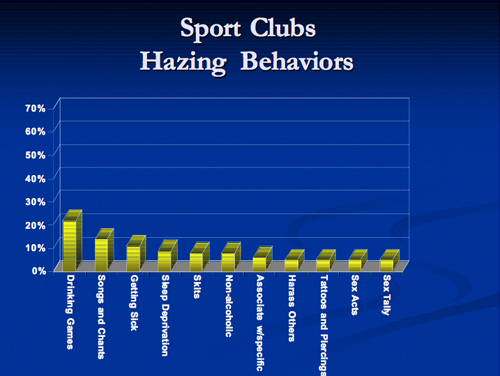|
Research
University of Maine Hazing Research
From the National Research Institute for College Recreational Sports & Wellness
 Overview Overview
Did you know that hazing has an impact on college recreational sports participants? NIRSA, aware of the commonality of hazing and its effects on recreational sports participants, has collaborated on a special research project taking place at the University of Maine. As part of the collaboration, a NIRSA liaison was designated to serve on the project advisory board. Other collaborating and sponsoring organizations include the NCAA, NASPA, American College Personnel Association, National Association of Campus Activities, Association of Student Judicial Affairs, and the Center for the Student of the College Fraternity, to name a few. Drs. Elizabeth Allan, Assistant Professor of Higher Educational Leadership and Mary Madden, Assistant Professor in the College of Education and Human Development, both from the University of Maine, serve as the investigators on the three-phase project. Phase I involved developing and pilot testing the hazing study survey. Phase II of the study, currently underway, involves refining the survey, recruiting institutions nationwide, and administering the survey. Finally, in Phase III, the researchers plan to present intervention models that administrators will be able to utilize.
Dr. Danell Haines reports that preliminary findings reflect hazing behaviors in college recreational sports participants, specifically sport clubs. To date, the researchers have analyzed answers from 1,789 students, representing four institutions in the Northeast. The students completed 70-question web-based surveys, which included questions about college and high school experiences related to hazing. The survey requested students to check all of the activities they are involved in and the degree and type of hazing that was experienced while affiliated with the group. Hazing was defined as “a dangerous behavior, unrelated to qualifications for a group, that one was compelled to engage in to be part of a group.” Preliminary results indicate that one in 20 students said they had been hazed at their current institution. Of interest, the ratio increased significantly when the hazing definition was applied to the student’s reported experiences.
The researchers found that hazing was reported across many types of teams and student organizations. Varsity athletes, members of social and service fraternities, band and performing arts members as well as those who participate in sport clubs all engaged in drinking games, were forced to sing or chant, and got sick or passed out from being forced to drink alcohol. Varsity athletes were by far the most likely group to participate in drinking games, with 60% of respondents from this group indicating that they had engaged in the behavior. The findings also indicate that coaches and advisors play a somewhat surprising part in hazing and rituals. Forty percent of the students who reported being involved in hazing behaviors also said that a coach or advisor was aware of the activity and 22% said their coach or advisor took part in the hazing rituals.
The survey revealed that students affiliated with a range of student groups reported experiencing hazing behaviors. Students were provided with a list of behaviors and asked if they had experienced any of the behaviors in the process of joining or maintaining membership in a student activity. The following is a partial list of the behaviors:
- Attend a skit night or roast where other members are humiliated
- Sing or chant by yourself or with a few select team members in a public situation that is not related to the event, game, or practice
- Wear clothing that is embarrassing and not part of the uniform
- Be yelled, screamed, or cursed at by other team/organization members
- Get a tattoo or pierce a body part
- Act as a personal servant to other members
- Associate with specific people and not others
- Deprive yourself of sleep
- Be awakened at night by other members
- Make prank phone calls or harass others
- Be tied up, taped, or confined to small spaces
- Be transported to and dropped off in an unfamiliar location
- Endure harsh weather without the proper clothing
- Drink large amounts of a non-alcoholic beverage such as water
- Participate in a drinking game
- Drink large amounts of alcohol to the point of passing out or getting sick
- Watch live sex acts
- Perform sex acts with the same gender
- Perform sex acts with the opposite gender
- Keep a tally of men or women with whom you have had sex
Among all respondents, the most common behaviors reported by students were as follows:
- 21% - Participate in a drinking game
- 15% - Sing or chant by self or with other selected group members
- 14% - Endure harsh weather conditions without proper clothing
- 12% - Deprive self of sleep
- 11% - Yelled, screamed, or cursed at by other group members
- 11% - Be awakened during night by other group members
Hazing Results Specific to Sport Clubs
The study examined hazing behaviors according to membership groups. The following graph illustrates the behaviors, and the percent of respondents who say they participated in the specific behaviors in order to join or maintain membership in Sport Clubs.

As observed, sport clubs participants are susceptible to many forms of hazing. For professionals in the field, this information is essential. It may allow for comparison of prevalence rates among college activities and an understanding of the scope of the hazing problem within sport clubs. It may also encourage awareness of hazing, behaviors common in hazing situations, and situations in which hazing is most common. These results may also lead to a better understanding of why hazing occurs, as well as to the development of programs designed to prevent hazing.
The investigators are in the process of recruiting institutions nationwide to participate in Phase II of the study. As results from Phase II of the project unfold, they will be shared with the NIRSA membership. For additional information about the hazing study see www.hazingstudy.com.
|

